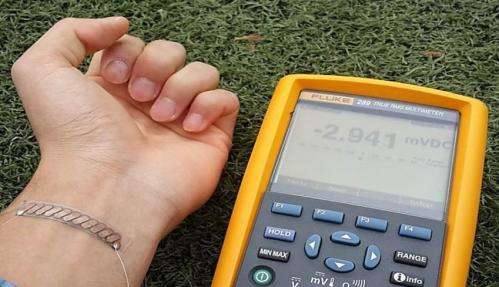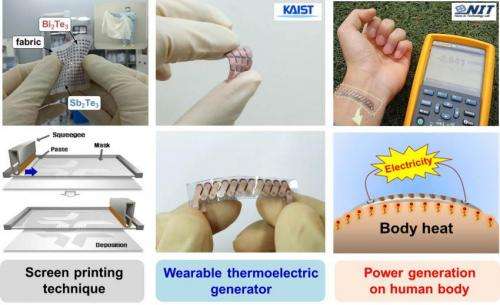April 12, 2014 weblog
Power arm band for wearables harvests body heat

(Phys.org) —A group of Korean researchers have turned their focus on supplying a reliable, efficient power source for wearables. Professor Byung Jin Cho of the Korea Advanced Institute of Science and Technology (KAIST) and his team, recognizing that supplying power that is stable and reliable is critical to the successful commercialization of wearables, have come up with a wearable power band that made technology news this week. The team noted that a flexible thermoelectric (TE) power generator would be the way to go to realize a wearable self-powered mobile device. They developed a wearable band-shaped item that produces electricity from the heat of the human body, The device size is 10 cm x 10 cm. Wearable electronics must be light, flexible, and equipped with a power source, which could be a portable, long-lasting battery or no battery at all but a generator, according to a KAIST release on Thursday, providing details about their work.
The concept and design technique involves building a thermoelectric (TE) generator that minimizes thermal energy loss. The release pointed out that thermo-elements are not new. To date two types of TE generators have been developed.
"The organic-based TE generators use polymers that are highly flexible and compatible with human skin, ideal for wearable electronics. The polymers, however, have a low power output. Inorganic-based TE generators produce a high electrical energy, but they are heavy, rigid, and bulky."
The distinguishing feature of the KAIST team's device is that their thermo-element is lightweight, high in electric power production efficiency, and is made with glass fiber. Said Prof. Cho: "The glass fabric itself serves as the upper and lower substrates of a TE generator, keeping the inorganic TE materials in between. This is quite a revolutionary approach to design a generator. In so doing, we were able to significantly reduce the weight of our generator (~0.13g/cm2), which is an essential element for wearable electronics."
The KAIST team's thermoelectric generator can be bent as many as 120 times, it was reported, but still showing high performance. The release noted its flexibility: "It is so flexible that the allowable bending radius of the generator is as low as 20 mm. There are no changes in performance even if the generator bends upward and downward for up to 120 cycles."

The release explained how the team "synthesized liquid-like pastes of n-type (Bi2Te3) and p-type (Sb2Te3) TE materials and printed them onto a glass fabric by applying a screen printing technique. The pastes permeated through the meshes of the fabric and formed films of TE materials in a range of thickness of several hundreds of microns. As a result, hundreds of TE material dots (in combination of n and p types) were printed and well arranged on a specific area of the glass fabric."
Research results about this band were published online in the March 14 issue of Energy & Environmental Science. "Wearable Thermoelectric Generator Fabricated on Glass Fabric" is authored by Sun Jin Kim, Ju Hyung We and Byung Jin Cho. The authors stated their generator is useful for wearables such as medical sensors and smart watches. "We herein demonstrate a glass fabric-based flexible TE generator using a screen printing technique and the self-sustaining structure of a TE device without top and bottom substrates. With this technique it is possible to make the device thin (~500 µm), lightweight (~0.13 g/cm2), and flexible. In addition, the developed TE generator achieved unprecedentedly large output power density which is several tens of times higher than flexible TE generators reported to date." The authors said the TE generator shows an allowable bending radius of as low as 20 mm and no change in performance by repeated bending for 120 cycles.
© 2014 Phys.org


















